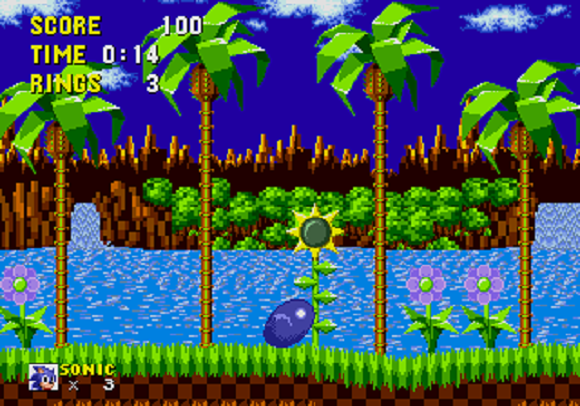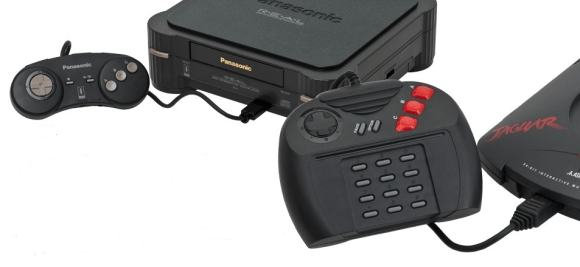You wouldn’t know it from the current state of the industry, but the biggest grudge match in video games wasn’t always PS4 versus Xbox One or Skyrim versus Dark Souls. For the bulk of console gaming’s most formative years, the bitterest rivalry was Nintendo versus Sega.
Back before Sega threw in the towel on making its own hardware, the two companies hated each other, and their fans did, too. “Nintendo makes games for little kids.” “Sega’s marketing is obnoxious and juvenile.” “The Super NES processor sucks.” “The Genesis sound chip sounds like a muffled fart.” “Mario is fat.” “Sonic only has one eyeball.”
Soon, you’ll be able to relive the epic struggle for 1990s video game supremacy with the feature film adaptation of the book “Console Wars: Sega, Nintendo, and the Battle that Defined a Generation.”
Seth Rogan and Evan Goldberg, the duo behind the 2007 comedy Superbad and co-directors of last year’s This Is the End, will be writing and directing the film, which is likely to see the print version’s lengthy title truncated to just Console Wars. Considering that the book itself, from author Blake Harris, doesn’t come out until the middle of next month, we’ve probably got a lengthy wait until the movie hits screens, but let’s take a look at the historical context of its setting.
For modern gamers, the concept of a full-on console war can be a little hard to properly conceptualize. With the exception of a handful of first party properties controlled by Nintendo, Sony, and Microsoft, most A-grade games eventually get released for multiple platforms. Often, you have to be a pretty enthusiastic enthusiast to spot the differences, not to mention a jaded fanboy to get that worked up over them.
Twenty years ago, though, things were very different. Video game console design was still an emerging field, and the high cost of components meant you couldn’t bring a system to market at a reasonable price with maxed-out specs across the board.
▼ At a reasonable price, we said!
Hardware designers had to make choices, and prioritizing one area necessitated settling for diminished capabilities in another. As a result, consoles created by different companies ended up with completely different performance profiles. In the 16-bit era, where Sega and Nintendo’s collision was the most violently head-on, the latter’s Super NES offered vibrant color, the first sound chip in a mass market console capable of passably replicating actual instruments as opposed to spitting out bleeps and bloops, and the scaling and rotating graphics effects package known as Mode 7. On the other hand, Sega’s Genesis had a processor several orders faster than the slouch Nintendo’s console was saddled with, enabling it to more easily move a larger number of on-screen objects, though not necessarily any more quickly than those in a Nintendo game.
▼ Blast Processing was never a real thing.
Such differing hardware also led to incongruous programming processes. The majority of software developers lacked the resources to have fully operating teams for both Nintendo’s and Sega’s consoles, and even those that did often had their hands tied by exclusivity contracts that were the order of the day in that era. Having to put all their eggs in one basket meant there were real consequences on the line for third-party software developers, as picking the losing side meant a shrunken pool of potential buyers, leading to lower profits at best and bankruptcy at worst.
Consumers faced a similar dilemma. If the system you bought didn’t sell well enough to build a large user base which could convince talented developers it was worth the time and risk to produce a game for it, your shiny new console would provide all the entertainment of a hard plastic footrest. For gamers in the early 1990s, especially those living in North America, the only two options that had a chance of panning out were Sega or Nintendo.
“But you guys missed out on the best Castlevania game ever!” shout the 27 TurboGrafx-16 owners who were hardcore enough to buy the CD add-on and mail-order import Rondo of Blood at its release in 1993.
While Sega’s 1989 release of the Genesis gave it a two-year head start on the Super NES in North America, the company immediately had a fight on its hands. Aside from the immediate recognition and respect that came with the Nintendo name, the Super NES’ audio and visual superiorities gave it an early edge in attracting young kids and their parents’ wallets. Nintendo’s hardware also was a better match for the slower-paced, atmosphere-driven role-playing games that consistently topped sales charts in Japan at the time.
Sega wasn’t going to go quietly, though, and Harris’ book promises to detail how the company not only picked itself up off the mat, but managed to at one point control more than half of the lucrative U.S. video game market. Harris gives much of the credit to Sega of America’s then-CEO Tom Kalinske’s corporate leadership. The U.K.’s The Guardian also points to the hit debut of Sega’s mascot in 1991 with the original Sonic the Hedgehog.
Also known as The Game that Killed Alex Kidd’s Career
The Guardian also writes that Sega’s surge was due to the CD add-on for the company’s 16-but console that shipped to American retailers in 1992, but considering its weak sales and almost complete lack of popular titles, we’re not sure it really helped Sega claw its way to the top.
We say almost complete lack of popular titles because Lunar was awesome.
As we recall it, while Sega did indeed get a big boost from the Sonic franchise, it got at least that much again, if not more, from its handling of the 1993 home version of ultra-gory fighting game Mortal Kombat. Whereas the Sega version had all of the blood and severed heads of the arcade original (albeit only after entering a code), on Super NES a fist to the face produced a fountain of sweat instead of hemoglobin.
In all fairness though, you really do have to punch a dude incredibly hard in order to make that much sweat fly off him.
Nintendo’s polarizing decision was applauded by overprotective parents. Unfortunately, it was ridiculed by people who actually bought and played games, who converted to Sega fans (and customers) in droves. Stung by the embarrassing and financial pain of the blunder, Nintendo would reverse its stance just a year later by allowing Mortal Kombat II to be released on the Super NES uncensored, as part of its attempted bad boy makeover “Play It Loud” marketing campaign. By then the damage was done, though, and the image had already cemented in many gamers’ minds that Nintendo was for babies and Sega was for badasses.
We’re looking forward to see which, if any, of these issues the Console Wars movie delves into, along with a host of other possibilities we haven’t touched on here. Hopefully, the movie will be a success, although if it isn’t perhaps the producers can recoup some of their losses with a cash grab direct-to-DVD sequel about the battle between the Panasonic 3DO and Atari Jaguar.
▼ Ending spoiler: everybody loses
Sources: Jin, The Guardian, RocketNews24
Insert images: Wikipedia, Sonic Retro, Wikipedia (2, 3), A Place of Games




 Sega throws ‘90s-era jabs at Nintendo in new video for latest Sonic game【Video】
Sega throws ‘90s-era jabs at Nintendo in new video for latest Sonic game【Video】 Sega’s video game consoles to live again as cute anime characters in Sega Hard Girls
Sega’s video game consoles to live again as cute anime characters in Sega Hard Girls Sega announces Game Gear Micro, an extra-tiny retro system with a startingly high price
Sega announces Game Gear Micro, an extra-tiny retro system with a startingly high price Nintendo’s Mario “borrows” one of Sonic the Hedgehog’s signature moves in his newest game
Nintendo’s Mario “borrows” one of Sonic the Hedgehog’s signature moves in his newest game Retro freak: the new system that lets you play cartridges from 11 different classic game consoles
Retro freak: the new system that lets you play cartridges from 11 different classic game consoles Majority of Japanese mayors say foreign residents are essential but most see good and bad effects
Majority of Japanese mayors say foreign residents are essential but most see good and bad effects The Purple Lucky Bag from Village Vanguard is an extra-large waste of money
The Purple Lucky Bag from Village Vanguard is an extra-large waste of money Japanese beef bowl chain Sukiya’s 2026 Smile Box lucky bag basically pays for itself
Japanese beef bowl chain Sukiya’s 2026 Smile Box lucky bag basically pays for itself Rakuten randomly offers 58 New Year’s osechi feasts in Japan, but did we get a star or a dud?
Rakuten randomly offers 58 New Year’s osechi feasts in Japan, but did we get a star or a dud? Four Shinto shrines to pray for love at in Japan to start the New Year
Four Shinto shrines to pray for love at in Japan to start the New Year Village Vanguard’s most expensive Black Lucky Bag sets an ominous tone for 2026
Village Vanguard’s most expensive Black Lucky Bag sets an ominous tone for 2026 Ho-Oh and Lugia desserts to descend on the Pokémon Cafe in Tokyo
Ho-Oh and Lugia desserts to descend on the Pokémon Cafe in Tokyo Birth Japan’s 2023 Lucky Bag will bring out your inner Japanese gangster【Photos】
Birth Japan’s 2023 Lucky Bag will bring out your inner Japanese gangster【Photos】 Treat Yourself to this Japanese Delicacy if You Dare – Ovaries From a Poisonous Fish!
Treat Yourself to this Japanese Delicacy if You Dare – Ovaries From a Poisonous Fish! Tokyo fish market breaks New Year auction record as single fish sells for over 5 million yen【Vid】
Tokyo fish market breaks New Year auction record as single fish sells for over 5 million yen【Vid】 Starbucks Japan ready to get Year of the Horse started with adorable drinkware and plushies【Pics】
Starbucks Japan ready to get Year of the Horse started with adorable drinkware and plushies【Pics】 Hayao Miyazaki says Happy New Year to Studio Ghibli fans with new art for Year of the Horse
Hayao Miyazaki says Happy New Year to Studio Ghibli fans with new art for Year of the Horse We found possibly the quietest Japanese-style hotel in Tokyo’s bustling Shinjuku district
We found possibly the quietest Japanese-style hotel in Tokyo’s bustling Shinjuku district Cup Noodle tries an authentic Jiro-style ramen, but something’s not quite right
Cup Noodle tries an authentic Jiro-style ramen, but something’s not quite right The best Starbucks Japan Frappuccinos we want to drink again in 2026
The best Starbucks Japan Frappuccinos we want to drink again in 2026 We revisited Sweets Paradise after a decade to see if Japan’s dessert buffet still delivers
We revisited Sweets Paradise after a decade to see if Japan’s dessert buffet still delivers That time Seiji called JASRAC to ask why he didn’t get paid royalties for his song being on TV
That time Seiji called JASRAC to ask why he didn’t get paid royalties for his song being on TV Japan’s oldest largetooth sawfish in captivity back on display in Mie Prefecture
Japan’s oldest largetooth sawfish in captivity back on display in Mie Prefecture Pizza Hut Japan’s hot lucky bags are perfect for a New Year’s pizza party
Pizza Hut Japan’s hot lucky bags are perfect for a New Year’s pizza party 7-Eleven Japan starts new temporary luggage storage service in over 300 branches
7-Eleven Japan starts new temporary luggage storage service in over 300 branches Disillusionment at Tsukiji’s tourist-target prices led us to a great ramen restaurant in Tokyo
Disillusionment at Tsukiji’s tourist-target prices led us to a great ramen restaurant in Tokyo Starbucks teams up with 166-year-old Kyoto doll maker for Year of the Horse decorations【Photos】
Starbucks teams up with 166-year-old Kyoto doll maker for Year of the Horse decorations【Photos】 Tokyo considering law requiring more trash cans following litter increase in heavily touristed area
Tokyo considering law requiring more trash cans following litter increase in heavily touristed area Tokyo’s Tsukiji sushi neighborhood asks tour groups to stay away for the rest of the month
Tokyo’s Tsukiji sushi neighborhood asks tour groups to stay away for the rest of the month Tokyo event lets you travel back in time, for free, to celebrate 100 years since Showa era start
Tokyo event lets you travel back in time, for free, to celebrate 100 years since Showa era start Japan may add Japanese language proficiency, lifestyle classes to permanent foreign resident requirements
Japan may add Japanese language proficiency, lifestyle classes to permanent foreign resident requirements Sanrio theme park in Japan announces plans to expand into a Sanrio resort
Sanrio theme park in Japan announces plans to expand into a Sanrio resort Stamina-destroying “Paralysis Noodles” are Tokyo’s newest over-the-top ramen innovation
Stamina-destroying “Paralysis Noodles” are Tokyo’s newest over-the-top ramen innovation Survey asks foreign tourists what bothered them in Japan, more than half gave same answer
Survey asks foreign tourists what bothered them in Japan, more than half gave same answer Japan’s human washing machines will go on sale to general public, demos to be held in Tokyo
Japan’s human washing machines will go on sale to general public, demos to be held in Tokyo Japan’s deadliest food claims more victims, but why do people keep eating it for New Year’s?
Japan’s deadliest food claims more victims, but why do people keep eating it for New Year’s? We deeply regret going into this tunnel on our walk in the mountains of Japan
We deeply regret going into this tunnel on our walk in the mountains of Japan Studio Ghibli releases Kodama forest spirits from Princess Mononoke to light up your home
Studio Ghibli releases Kodama forest spirits from Princess Mononoke to light up your home Major Japanese hotel chain says reservations via overseas booking sites may not be valid
Major Japanese hotel chain says reservations via overseas booking sites may not be valid Put sesame oil in your coffee? Japanese maker says it’s the best way to start your day【Taste test】
Put sesame oil in your coffee? Japanese maker says it’s the best way to start your day【Taste test】 No more using real katana for tourism activities, Japan’s National Police Agency says
No more using real katana for tourism activities, Japan’s National Police Agency says Starbucks Japan reveals new sakura drinkware collection, inspired by evening cherry blossoms
Starbucks Japan reveals new sakura drinkware collection, inspired by evening cherry blossoms Updated cherry blossom forecast shows extra-long sakura season for Japan this year
Updated cherry blossom forecast shows extra-long sakura season for Japan this year Sega’s Mega Drive/Genesis lives again, is back in production 28 years after its initial launch
Sega’s Mega Drive/Genesis lives again, is back in production 28 years after its initial launch Scale SEGA! Game company’s greatest consoles recreated in miniature for your figures to play with
Scale SEGA! Game company’s greatest consoles recreated in miniature for your figures to play with Old-School console war reignites: Sega releases mini Mega Drive/Genesis against tiny Nintendo NES
Old-School console war reignites: Sega releases mini Mega Drive/Genesis against tiny Nintendo NES Happy birthday, Famicom! The console that bought video games back from the dead turns 31 today
Happy birthday, Famicom! The console that bought video games back from the dead turns 31 today Pretend you’re Sony or Nintendo as you devour Sega with Tokyo’s new Sega Logo-yaki sweet
Pretend you’re Sony or Nintendo as you devour Sega with Tokyo’s new Sega Logo-yaki sweet Classic 16-bit Nintendo controllers get modern makeover for use with Switch, current-gen consoles
Classic 16-bit Nintendo controllers get modern makeover for use with Switch, current-gen consoles Sega builds “world’s fastest gaming PC,” is giving it away for free (processor speed unknown)【Vid】
Sega builds “world’s fastest gaming PC,” is giving it away for free (processor speed unknown)【Vid】 Keep your iPhone safe and retro-gamer chic with Famicom protective film
Keep your iPhone safe and retro-gamer chic with Famicom protective film “Coincidentally” named video game handhelds allow you to play 8, 16-bit Nintendo games on the go
“Coincidentally” named video game handhelds allow you to play 8, 16-bit Nintendo games on the go Two Sega fans get married in Japan, win at weddings with awesome Mega Drive wedding cake【Pics】
Two Sega fans get married in Japan, win at weddings with awesome Mega Drive wedding cake【Pics】 Cuddly Sega Mega Drive plushie, Dreamcast hoodies and more on sale at this year’s Tokyo Game Show
Cuddly Sega Mega Drive plushie, Dreamcast hoodies and more on sale at this year’s Tokyo Game Show All aboard the Sega Train! Tokyo rail operator decorates carriages for Sonic’s 25th anniversary
All aboard the Sega Train! Tokyo rail operator decorates carriages for Sonic’s 25th anniversary Game over for Classic Mini Famicom and Super Famicom as Nintendo announces end of repairs
Game over for Classic Mini Famicom and Super Famicom as Nintendo announces end of repairs Charge up your new tech with a nod to old games with Famicom controller battery pack/card reader
Charge up your new tech with a nod to old games with Famicom controller battery pack/card reader Good God the live-action Sonic the Hedgehog movie trailer looks weird【Video】
Good God the live-action Sonic the Hedgehog movie trailer looks weird【Video】 Even Sonic the Hedgehog’s original creator thinks character’s live-action movie design is ugly
Even Sonic the Hedgehog’s original creator thinks character’s live-action movie design is ugly
Leave a Reply